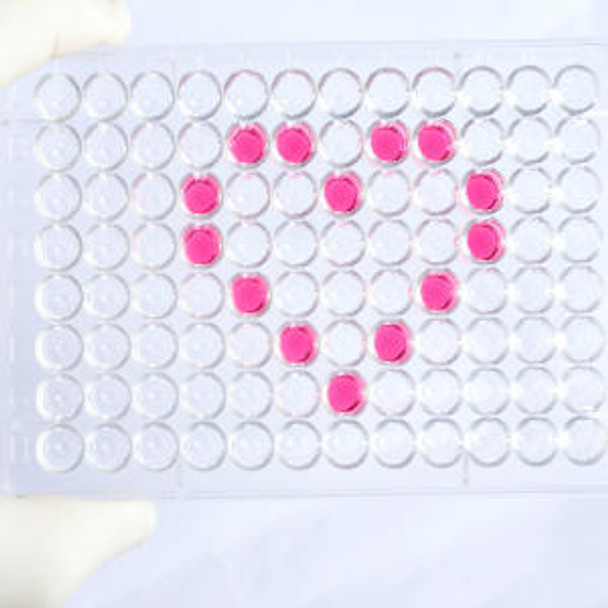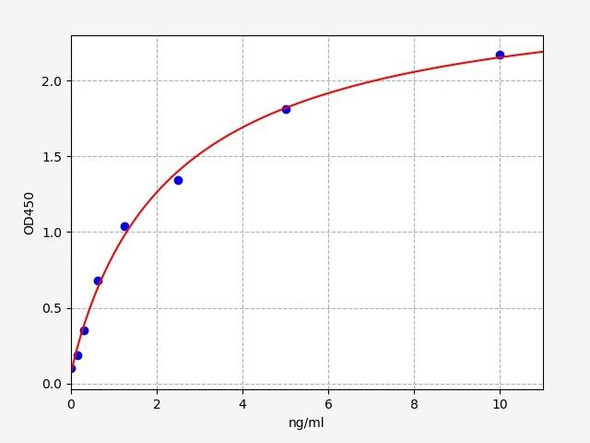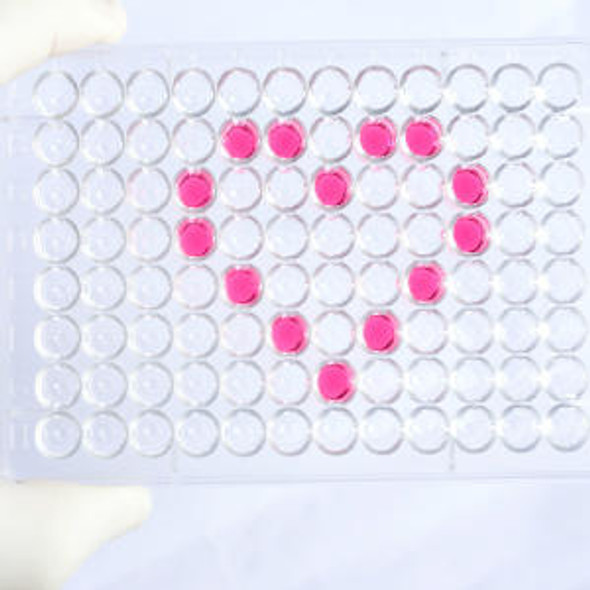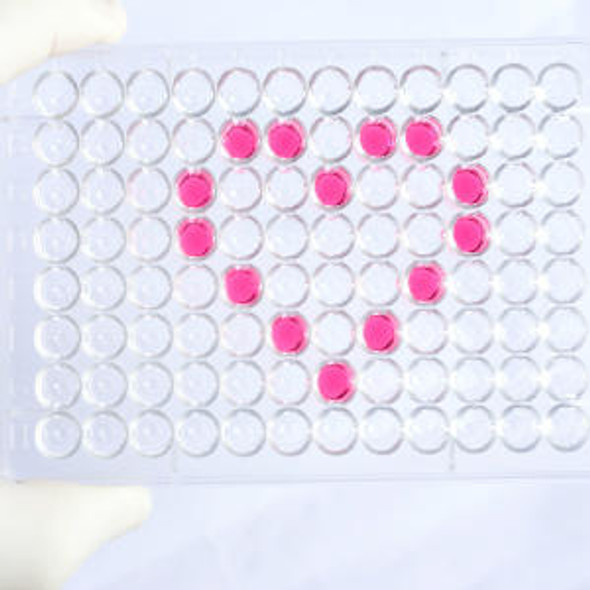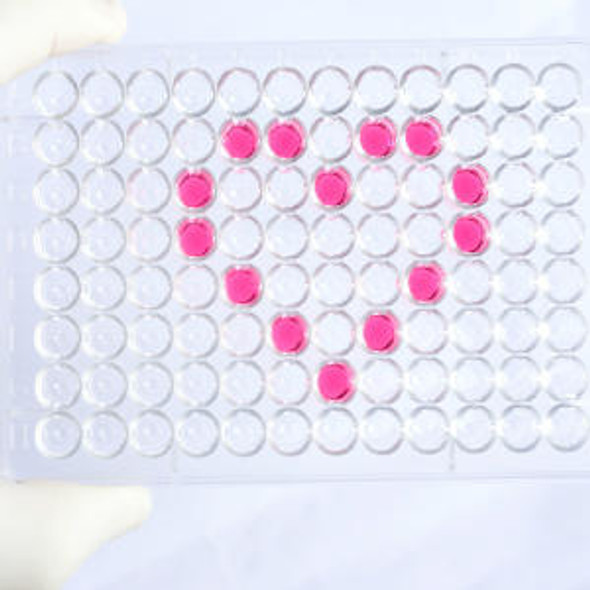Human Serine/threonine-protein kinase mTOR (MTOR) ELISA Kit
- SKU:
- HUEB1625
- Product Type:
- ELISA Kit
- Size:
- 96 Assays
- Uniprot:
- P42345
- Range:
- 78-5000 pg/mL
- ELISA Type:
- Sandwich
- Synonyms:
- MTOR, Serine, threonine-protein kinase mTOR
- Reactivity:
- Human
Description
| Product Name: | Human Serine/threonine-protein kinase mTOR (MTOR) ELISA Kit |
| Product Code: | HUEB1625 |
| Alias: | Serine/threonine-protein kinase mTOR, FK506-binding protein 12-rapamycin complex-associated protein 1, FKBP12-rapamycin complex-associated protein, Mammalian target of rapamycin, mTOR, Mechanistic target of rapamycin, Rapamycin target protein 1, RAPT1, MTOR, FRAP, FRAP1, FRAP2, 2.7.11.1, Rapamycin target protein 1, RAFT1, RAPT1 |
| Uniprot: | P42345 |
| Reactivity: | Human |
| Range: | 78-5000 pg/mL |
| Detection Method: | Sandwich |
| Size: | 96 Assay |
| Storage: | Please see kit components below for exact storage details |
| Note: | For research use only |
| UniProt Protein Function: | mTOR: an atypical kinase belonging to the PIKK family of kinases. Is the catalytic subunit of two protein complexes, mTORC1 and mTORC2. mTORC1 activates S6K and inactivates 4E-BP1, up-regulating protein synthesis. mTORC1 contains Raptor, a positive regulatory subunit and scaffold for recruiting substrates, two negative regulators, PRAS40 and DEPTOR, and mLST8; it is a target for the cell-cycle arrest and immunosuppressive effects of the FKBP12-rapamycin complex. mTORC2, a downstream effector of PI3K, is insensitive to rapamycin and activates Akt by phosphorylating a key activation site. mTORC2 contains regulatory subunits Rictor and mSIN1, PROTOR, mLST8, and the negative regulator DEPTOR. mTORC1 suppresses PI3K activity via a strong negative feedback loop that involves S6K1. Inhibiting mTORC1 ablates this negative feedback loop and potentiates PI3K signaling. Known inhibitors of mTOR include rapamycin, temsirolimus (CCI-779). |
| UniProt Protein Details: | Protein type:Protein kinase, atypical; Motility/polarity/chemotaxis; Protein kinase, Ser/Thr (non-receptor); Autophagy; EC 2.7.11.1; Kinase, protein; ATYPICAL group; PIKK family; FRAP subfamily Chromosomal Location of Human Ortholog: 1p36.2 Cellular Component: cell soma; cytoplasm; cytosol; dendrite; endomembrane system; endoplasmic reticulum membrane; Golgi membrane; lysosomal membrane; lysosome; membrane; mitochondrial outer membrane; nucleoplasm; phosphoinositide 3-kinase complex; PML body; TORC2 complex Molecular Function:ATP binding; drug binding; kinase activity; phosphoprotein binding; protein binding; protein domain specific binding; protein kinase binding; protein serine/threonine kinase activity; ribosome binding Biological Process: 'de novo' pyrimidine base biosynthetic process; brain development; cardiac muscle cell development; cardiac muscle contraction; cell aging; cell cycle arrest; cell growth; cellular response to nutrient levels; DNA repair; energy reserve metabolic process; epidermal growth factor receptor signaling pathway; fibroblast growth factor receptor signaling pathway; gene expression; germ cell development; growth; heart morphogenesis; innate immune response; insulin receptor signaling pathway; long-term memory; macroautophagy; maternal process involved in pregnancy; mRNA stabilization; multicellular organism growth; negative regulation of autophagy; negative regulation of cell size; negative regulation of muscle atrophy; negative regulation of NFAT protein import into nucleus; negative regulation of protein amino acid phosphorylation; negative regulation of protein ubiquitination; nerve growth factor receptor signaling pathway; peptidyl-serine phosphorylation; peptidyl-threonine phosphorylation; phosphoinositide-mediated signaling; phosphorylation; positive regulation of actin filament polymerization; positive regulation of endothelial cell proliferation; positive regulation of lipid biosynthetic process; positive regulation of neuron maturation; positive regulation of nitric oxide biosynthetic process; positive regulation of oligodendrocyte differentiation; positive regulation of peptidyl-tyrosine phosphorylation; positive regulation of protein amino acid phosphorylation; positive regulation of protein kinase B signaling cascade; positive regulation of smooth muscle cell proliferation; positive regulation of stress fiber formation; positive regulation of transcription from RNA polymerase III promoter; positive regulation of translation; post-embryonic development; protein amino acid autophosphorylation; protein amino acid phosphorylation; protein catabolic process; regulation of actin cytoskeleton organization and biogenesis; regulation of carbohydrate utilization; regulation of fatty acid beta-oxidation; regulation of glycogen biosynthetic process; regulation of GTPase activity; regulation of myelination; regulation of osteoclast differentiation; regulation of protein kinase activity; regulation of response to food; response to amino acid stimulus; response to cocaine; response to morphine; response to nutrient; response to stress; ruffle organization and biogenesis; signal transduction; social behavior; spinal cord development; T cell costimulation; TOR signaling pathway; transcription initiation from RNA polymerase II promoter; vascular endothelial growth factor receptor signaling pathway; visual learning; voluntary musculoskeletal movement; wound healing |
| NCBI Summary: | The protein encoded by this gene belongs to a family of phosphatidylinositol kinase-related kinases. These kinases mediate cellular responses to stresses such as DNA damage and nutrient deprivation. This protein acts as the target for the cell-cycle arrest and immunosuppressive effects of the FKBP12-rapamycin complex. The ANGPTL7 gene is located in an intron of this gene. [provided by RefSeq, Sep 2008] |
| UniProt Code: | P42345 |
| NCBI GenInfo Identifier: | 1169735 |
| NCBI Gene ID: | 2475 |
| NCBI Accession: | P42345.1 |
| UniProt Secondary Accession: | P42345,Q4LE76, Q5TER1, Q6LE87, Q96QG3, Q9Y4I3, |
| UniProt Related Accession: | P42345 |
| Molecular Weight: | 288,892 Da |
| NCBI Full Name: | Serine/threonine-protein kinase mTOR |
| NCBI Synonym Full Names: | mechanistic target of rapamycin |
| NCBI Official Symbol: | MTOR |
| NCBI Official Synonym Symbols: | SKS; FRAP; FRAP1; FRAP2; RAFT1; RAPT1 |
| NCBI Protein Information: | serine/threonine-protein kinase mTOR |
| UniProt Protein Name: | Serine/threonine-protein kinase mTOR |
| UniProt Synonym Protein Names: | FK506-binding protein 12-rapamycin complex-associated protein 1; FKBP12-rapamycin complex-associated protein; Mammalian target of rapamycin; mTOR; Mechanistic target of rapamycin; Rapamycin and FKBP12 target 1; Rapamycin target protein 1 |
| Protein Family: | Serine/threonine-protein kinase |
| UniProt Gene Name: | MTOR |
| UniProt Entry Name: | MTOR_HUMAN |
| Component | Quantity (96 Assays) | Storage |
| ELISA Microplate (Dismountable) | 8×12 strips | -20°C |
| Lyophilized Standard | 2 | -20°C |
| Sample Diluent | 20ml | -20°C |
| Assay Diluent A | 10mL | -20°C |
| Assay Diluent B | 10mL | -20°C |
| Detection Reagent A | 120µL | -20°C |
| Detection Reagent B | 120µL | -20°C |
| Wash Buffer | 30mL | 4°C |
| Substrate | 10mL | 4°C |
| Stop Solution | 10mL | 4°C |
| Plate Sealer | 5 | - |
Other materials and equipment required:
- Microplate reader with 450 nm wavelength filter
- Multichannel Pipette, Pipette, microcentrifuge tubes and disposable pipette tips
- Incubator
- Deionized or distilled water
- Absorbent paper
- Buffer resevoir
*Note: The below protocol is a sample protocol. Protocols are specific to each batch/lot. For the correct instructions please follow the protocol included in your kit.
Allow all reagents to reach room temperature (Please do not dissolve the reagents at 37°C directly). All the reagents should be mixed thoroughly by gently swirling before pipetting. Avoid foaming. Keep appropriate numbers of strips for 1 experiment and remove extra strips from microtiter plate. Removed strips should be resealed and stored at -20°C until the kits expiry date. Prepare all reagents, working standards and samples as directed in the previous sections. Please predict the concentration before assaying. If values for these are not within the range of the standard curve, users must determine the optimal sample dilutions for their experiments. We recommend running all samples in duplicate.
| Step | |
| 1. | Add Sample: Add 100µL of Standard, Blank, or Sample per well. The blank well is added with Sample diluent. Solutions are added to the bottom of micro ELISA plate well, avoid inside wall touching and foaming as possible. Mix it gently. Cover the plate with sealer we provided. Incubate for 120 minutes at 37°C. |
| 2. | Remove the liquid from each well, don't wash. Add 100µL of Detection Reagent A working solution to each well. Cover with the Plate sealer. Gently tap the plate to ensure thorough mixing. Incubate for 1 hour at 37°C. Note: if Detection Reagent A appears cloudy warm to room temperature until solution is uniform. |
| 3. | Aspirate each well and wash, repeating the process three times. Wash by filling each well with Wash Buffer (approximately 400µL) (a squirt bottle, multi-channel pipette,manifold dispenser or automated washer are needed). Complete removal of liquid at each step is essential. After the last wash, completely remove remaining Wash Buffer by aspirating or decanting. Invert the plate and pat it against thick clean absorbent paper. |
| 4. | Add 100µL of Detection Reagent B working solution to each well. Cover with the Plate sealer. Incubate for 60 minutes at 37°C. |
| 5. | Repeat the wash process for five times as conducted in step 3. |
| 6. | Add 90µL of Substrate Solution to each well. Cover with a new Plate sealer and incubate for 10-20 minutes at 37°C. Protect the plate from light. The reaction time can be shortened or extended according to the actual color change, but this should not exceed more than 30 minutes. When apparent gradient appears in standard wells, user should terminatethe reaction. |
| 7. | Add 50µL of Stop Solution to each well. If color change does not appear uniform, gently tap the plate to ensure thorough mixing. |
| 8. | Determine the optical density (OD value) of each well at once, using a micro-plate reader set to 450 nm. User should open the micro-plate reader in advance, preheat the instrument, and set the testing parameters. |
| 9. | After experiment, store all reagents according to the specified storage temperature respectively until their expiry. |
When carrying out an ELISA assay it is important to prepare your samples in order to achieve the best possible results. Below we have a list of procedures for the preparation of samples for different sample types.
| Sample Type | Protocol |
| Serum | If using serum separator tubes, allow samples to clot for 30 minutes at room temperature. Centrifuge for 10 minutes at 1,000x g. Collect the serum fraction and assay promptly or aliquot and store the samples at -80°C. Avoid multiple freeze-thaw cycles. If serum separator tubes are not being used, allow samples to clot overnight at 2-8°C. Centrifuge for 10 minutes at 1,000x g. Remove serum and assay promptly or aliquot and store the samples at -80°C. Avoid multiple freeze-thaw cycles. |
| Plasma | Collect plasma using EDTA or heparin as an anticoagulant. Centrifuge samples at 4°C for 15 mins at 1000 × g within 30 mins of collection. Collect the plasma fraction and assay promptly or aliquot and store the samples at -80°C. Avoid multiple freeze-thaw cycles. Note: Over haemolysed samples are not suitable for use with this kit. |
| Urine & Cerebrospinal Fluid | Collect the urine (mid-stream) in a sterile container, centrifuge for 20 mins at 2000-3000 rpm. Remove supernatant and assay immediately. If any precipitation is detected, repeat the centrifugation step. A similar protocol can be used for cerebrospinal fluid. |
| Cell culture supernatant | Collect the cell culture media by pipette, followed by centrifugation at 4°C for 20 mins at 1500 rpm. Collect the clear supernatant and assay immediately. |
| Cell lysates | Solubilize cells in lysis buffer and allow to sit on ice for 30 minutes. Centrifuge tubes at 14,000 x g for 5 minutes to remove insoluble material. Aliquot the supernatant into a new tube and discard the remaining whole cell extract. Quantify total protein concentration using a total protein assay. Assay immediately or aliquot and store at ≤ -20 °C. |
| Tissue homogenates | The preparation of tissue homogenates will vary depending upon tissue type. Rinse tissue with 1X PBS to remove excess blood & homogenize in 20ml of 1X PBS (including protease inhibitors) and store overnight at ≤ -20°C. Two freeze-thaw cycles are required to break the cell membranes. To further disrupt the cell membranes you can sonicate the samples. Centrifuge homogenates for 5 mins at 5000xg. Remove the supernatant and assay immediately or aliquot and store at -20°C or -80°C. |
| Tissue lysates | Rinse tissue with PBS, cut into 1-2 mm pieces, and homogenize with a tissue homogenizer in PBS. Add an equal volume of RIPA buffer containing protease inhibitors and lyse tissues at room temperature for 30 minutes with gentle agitation. Centrifuge to remove debris. Quantify total protein concentration using a total protein assay. Assay immediately or aliquot and store at ≤ -20 °C. |
| Breast Milk | Collect milk samples and centrifuge at 10,000 x g for 60 min at 4°C. Aliquot the supernatant and assay. For long term use, store samples at -80°C. Minimize freeze/thaw cycles. |

